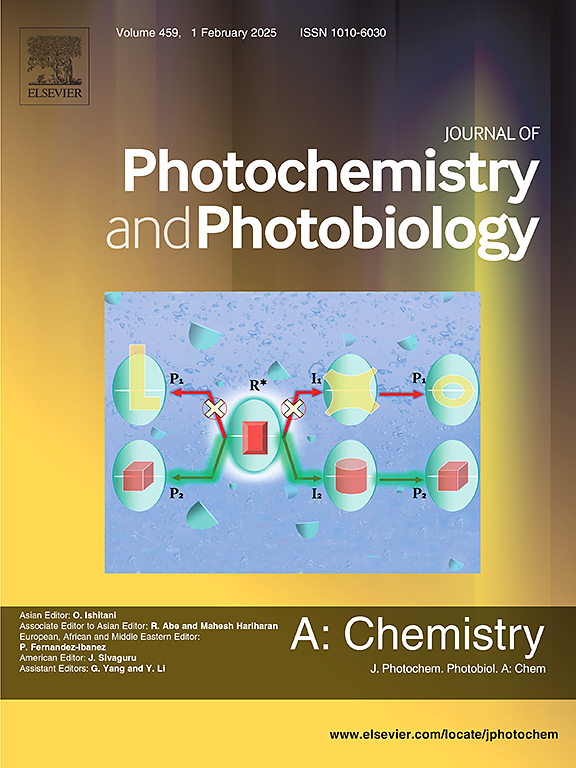t-GeC和g-GeC的电学和光学性质的计算研究
IF 4.7
3区 化学
Q2 CHEMISTRY, PHYSICAL
Journal of Photochemistry and Photobiology A-chemistry
Pub Date : 2025-05-17
DOI:10.1016/j.jphotochem.2025.116508
引用次数: 0
摘要
二维(2D)材料,如石墨烯、过渡金属二硫族化合物和金属有机框架,由于其大的表面积和可调谐的电子特性,已经证明了增强的催化性能和效率。其中,碳化锗(GeC)单层,包括石墨GeC (g-GeC), 2D-GeC和类金刚石GeC (d-GeC)在光催化应用中表现出重要的前景。例如,g-GeC已被探索作为燃料电池和锂氧电池的阴极催化剂,而2D-GeC已被研究其合成方法,基本性质和光催化应用。计算模型表明,可以有效地合成二维形式的锗石墨烯。在这项工作中,我们利用密度泛函理论(DFT)计算Wien2k代码,研究了两种石墨烯单层,四方GeC (t-GeC)和g-GeC的光催化、电学和光学性质。结果表明,t-GeC和g-GeC在特定的N向量上都表现出直接的带隙,这是由它们的电子性质证实的。此外,这些材料表现出对可见光的强吸收,使它们适合于太阳能驱动的光催化过程。电荷密度分析提供了Ge和C原子之间电荷分布的见解,揭示了它们的键和电子相互作用。这些发现突出了石墨烯的光催化潜力,将其定位为可再生能源技术中应用的有前途的材料,例如太阳能收集和水分解。本文章由计算机程序翻译,如有差异,请以英文原文为准。

Computational study of electrical and optical properties of t-GeC and g-GeC
Two-dimensional (2D) materials, such as graphene, transition metal dichalcogenides, and metal–organic frameworks, have demonstrated enhanced catalytic performance and efficiency, owing to their large surface areas and tunable electronic properties. Among these, germanium carbide (GeC) monolayers, including graphitic GeC (g-GeC), 2D-GeC, and diamond-like GeC (d-GeC) have shown significant promise for photocatalytic applications. For instance, g-GeC has been explored as a cathode catalyst for fuel cells and lithium-oxygen batteries, while 2D-GeC has been studied for its synthetic methods, fundamental properties, and photocatalytic applications. Computational modeling suggests that germagraphene, a 2D form of GeC, may be effectively synthesized. In this work, we investigate the photocatalytic, electrical, and optical properties of two germagraphene monolayers, tetragonal GeC (t-GeC) and g-GeC, using density functional theory (DFT) calculations performed with the Wien2k code. The results reveal that both t-GeC and g-GeC exhibit direct band gaps along specific N vectors, as confirmed by their electronic properties. Furthermore, these materials demonstrate strong absorption of visible sunlight, making them suitable for solar-driven photocatalytic processes. Charge density analysis provides insights into the distribution of charge between Ge and C atoms, shedding light on their bonding and electronic interactions. These findings highlight the photocatalytic potential of germagraphene, positioning it as a promising material for applications in renewable energy technologies, such as solar energy harvesting and water splitting.
求助全文
通过发布文献求助,成功后即可免费获取论文全文。
去求助
来源期刊
CiteScore
7.90
自引率
7.00%
发文量
580
审稿时长
48 days
期刊介绍:
JPPA publishes the results of fundamental studies on all aspects of chemical phenomena induced by interactions between light and molecules/matter of all kinds.
All systems capable of being described at the molecular or integrated multimolecular level are appropriate for the journal. This includes all molecular chemical species as well as biomolecular, supramolecular, polymer and other macromolecular systems, as well as solid state photochemistry. In addition, the journal publishes studies of semiconductor and other photoactive organic and inorganic materials, photocatalysis (organic, inorganic, supramolecular and superconductor).
The scope includes condensed and gas phase photochemistry, as well as synchrotron radiation chemistry. A broad range of processes and techniques in photochemistry are covered such as light induced energy, electron and proton transfer; nonlinear photochemical behavior; mechanistic investigation of photochemical reactions and identification of the products of photochemical reactions; quantum yield determinations and measurements of rate constants for primary and secondary photochemical processes; steady-state and time-resolved emission, ultrafast spectroscopic methods, single molecule spectroscopy, time resolved X-ray diffraction, luminescence microscopy, and scattering spectroscopy applied to photochemistry. Papers in emerging and applied areas such as luminescent sensors, electroluminescence, solar energy conversion, atmospheric photochemistry, environmental remediation, and related photocatalytic chemistry are also welcome.

 求助内容:
求助内容: 应助结果提醒方式:
应助结果提醒方式:


